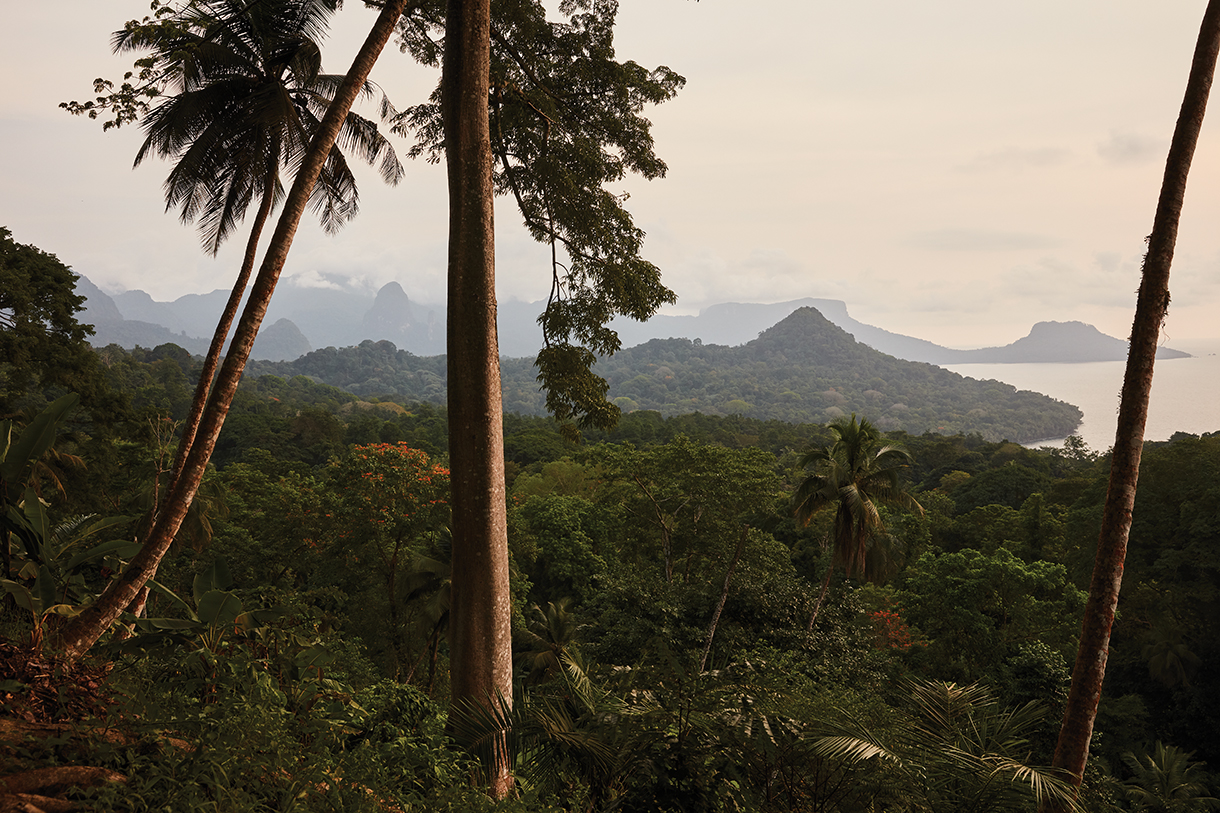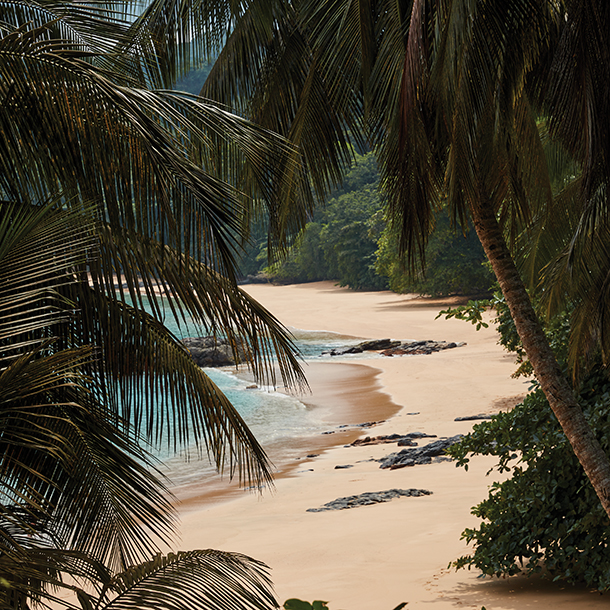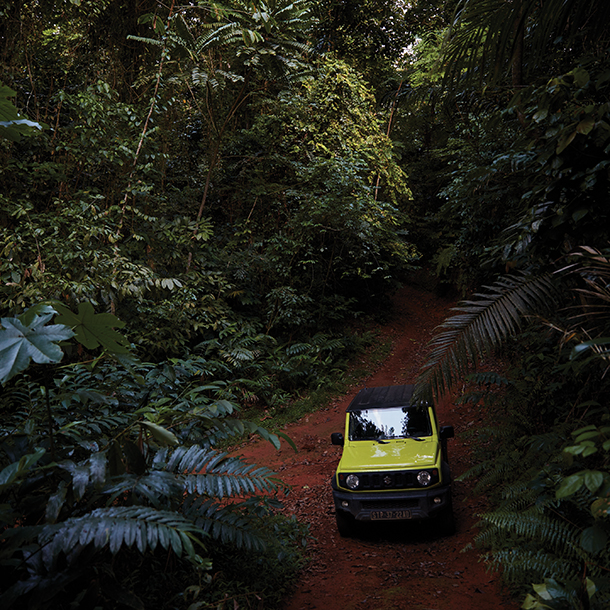
Chocolate Islands Reborn


Ecotourism Revives São Tomé and Príncipe's Legacy
The place where bitter and sweet meet is an obsession. For these are “The Chocolate Islands,” where the power of the soft, creamy melt fuels São Tomé and Príncipe—a two-island nation straddling the equator that was at one time the largest cocoa producer in the world. This century-old industry has since come back to life, and the arrival of bold new ventures in ecotourism means they’re finally reclaiming that title.
Landing on the island of Príncipe gives you the sense of just how far to the edge of Africa you’ve come. The mountains here are steep, the jungles are deep, and the winds have blown you into another world. At first glance, this is Africa at its most ideal; a mysterious fairytale of tropical perfection that grown-ups told you didn’t exist. The forest teems with life: 1,000 ancient specimens coexist in a showcase of diversity in its most purposeful sense, as if to look at us humans and say, let us show you how it’s done.
This isn’t the Africa you know from safari brochures or developing nations fundraisers. This protected jewel of an island, in its remoteness, lies 120 miles from the jungles of Gabon to the east, the chaos of Nigeria to the north, and a world away from every safari tent and beach resort you have ever known. If you mention Príncipe to your friends, it’s a guarantee they will have no idea what you are talking about.
The Portuguese discovered São Tomé and Príncipe in the late 1400s, establishing the islands as a trading post between Portugal and the rest of Africa. Some of the earliest settlers were Portuguese prisoners and Jewish children, who were forcibly separated from their parents at the hands of the king. As the nation became Africa’s top sugar exporter, the sheer number of workers needed for production turned the island into a slave trading post between the African mainland and Brazil.
By the 1800s, the sugar industry fell into decline, as the climate became too humid for the sugar to properly dry. Yet rich volcanic soil and year-round hot conditions were well suited to cacao and coffee farming. By the early 1900s, São Tomé had become the world’s largest producer of cacao.
The plantations were large, like villages unto themselves, with hospitals, housing, and cocoa production facilities. Cacao farming, historically, was very tough not just on laborers, but on the land itself, due to aggressive agricultural practices that didn’t keep the future in mind. When the islands gained independence from Portugal in 1975, plantation managers went back home and the cacao industry burned out. Of late, the farms and colonial architecture have been given a new lease on life, thanks to the man who rediscovered Príncipe. Enter Mark Shuttleworth, the South African tech entrepreneur and astronaut who fell in love with the place just over a decade ago. At that time, there was as much poverty as potential and Shuttleworth had a vision. In 2010 he founded HBD Príncipe, an ecotourism and agroforestry group named after the abbreviation for “Here Be Dragons,” a phrase used by early explorers marking uncharted territory.
For island residents versed in farming, fishing, and forestry, tourism was an uncharted challenge, but one that gave new purpose to their knowledge. Shuttleworth’s $100 million investment has succeeded, creating four eco-resorts that employ more than 600 locals and operate to protect the island’s incomparable nature—saving it from being deforested for a proposed 2,500-acre palm oil plantation. Working in collaboration with the local government, HBD achieved another major victory in 2012, earning UNESCO Biosphere Reserve status for the entire island and designating its southern half as protected wilderness.

During a period of intense poverty in the ’90s, locals turned to the forest to use and rediscover the flavors and medicines of their ancestors. Today, guides disappear into the thick woods and emerge minutes later with mangungo (an odd-looking red fruit with seeds used as a natural sweetener) and ossame (a delightfully sour condiment). Roça Sundy’s farm grows peppers, vanilla, coffee, bananas, and cacao, and the wild forest yields more exotic flavors if you dare.
Thanks to HBD’s agroforestry approach to farming, cacao trees now flourish in the rainforest, sequestering carbon, avoiding deforestation, and providing more biodiversity than traditional monoculture. Cacao farming lies in many families’ bloodlines, and this new approach transforms the physical demands of years past into a future they can take pride in. Blending old techniques with new ones, HBD chocolatiers have successfully launched their “tree-to-bar,” single-origin chocolate. Príncipe never had an indigenous population and despite a dark and winding history, its story has been rewritten. To tell it now, it’s a tale of inspiring resilience, embracing what the natural world provides, and healing history with time and intention. Walking down a dark beach under the stars with distant flashes of lightning from a nearby storm, hundreds of nocturnal crabs scatter around your feet. Wildlife guides hand out tiny red flashlights and lead you farther into the dark to witness giant sea turtles laying their eggs on shore. In the darkest of night, no matter what your past has held, you can always birth something new before returning out to sea. Only 1 out of 1,000 sea turtles survive. On Príncipe you feel like one of the lucky few. hbdprincipe.com


Lisbon Layover
Before transiting onward to Príncipe, spend a few days in Portugal’s capital for a clearer picture of São Tomé’s origins of discovery. History comes alive at the AlmaLusa Hotels (almalusahotels.com), a collection of three high-end boutique properties that take hospitality to another level. Guests are given old-school room keys and the staff acts like a personal concierge curating experiences to the city’s best hidden gems.The AlmaLusa Baixa/Chiado (from $150) is the impeccably restored former Lisbon arsenal building, with giant stone slab floors in the lobby and fossils found during the building’s restoration.
The newly opened AlmaLusa Alfama (from $195), a waterfront building that traces its roots back to the 12th century, straddles the Arco das Portas do Mar, the Roman-era stone archway marking the official gateway into the ancient city.
The AlmaLusa Comporta’s (from $160) earthy elegance offers a variety of beachy suites, located a 1.5-hour drive from Lisbon, and a short walk from one of the most stunning beaches on the Alentejo coast.
Logistics
While São Tomé and Príncipe may look remote on a map, TAP Air Portugal offers easy connections from many North American cities to Lisbon. Their new Airbus A321Neo takes you to São Tomé (six hours from Lisbon) in comfort with lie-flat business-class seats. flytap.comAfter landing in São Tomé, the Omali lodge (from $205, breakfast included) is close to the airport and a day trip around the island is a must.
STP Airways runs a quick, 45-minute hopper flight to Príncipe. stpairways.st
Príncipe’s three luxury properties:
Roça Sundy (from $500, half board plus activities) spreads across two historic plantation houses with 15 beautifully appointed rooms.
At Sundy Praia (from $1,240, half board plus activities), stay among the collection of 15 beachside, tented eco-villas.
The 17 beach bungalows at Bom Bom ($620, half board) will reopen in September.
Photo Credits: Courtesy Jonathan Pozniak




